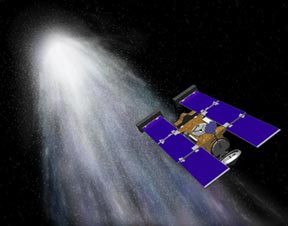Click on image for full size
Image courtesy NASA/JPL.
Stardust comet sample return mission
NASA's Stardust mission was the first spacecraft to collect samples of material directly from a comet and return them to Earth. Stardust was launched by a Delta 2 rocket from Cape Canaveral Air Station, Florida, on February 7, 1999. On January 2, 2004, the spacecraft flew within 240 kilometers (149 miles) of Comet Wild 2. It used an ultra-lightweight material called aerogel to capture many tiny (10 to 300 microns in diameter) particles of cometary material as they whizzed by the spacecraft at the tremendous speed of 21,960 kilometers (13,650 miles) per hour. The comet samples were stowed in a capsule that was later returned to Earth, parachuting to a landing in the Utah desert in January 2006.
Stardust took a roundabout route to its rendezvous with a comet. During the course of its mission, the spacecraft completed three full orbits around the Sun. Along the way it also scooped up a few particles of interstellar dust as they floated through the lonely voids of our Solar System far from any planets.
Some of the early findings, based on analysis of samples returned by Stardust, have given scientists a surprise. Dubbed "Fire and Ice", the comet samples show an expected abundance of ice, but also an unexpected abundance of minerals that form at high temperatures. These minerals would normally form very near the Sun (or some other star?!). How they would end up in comets out on the frozen fringe of the Solar System puzzles astronomers.
Stardust also captured some of the best images yet obtained of the nucleus of a comet during its flyby of Wild 2. Scientists are especially interested in studying Comet Wild 2 because it is a relatively "fresh" comet. Up until 1974, Wild 2 had been drifting in the outer regions of our Solar System in cold storage, so it should still have material leftover from the earliest days of our Solar System. Scientists are eagerly studying the samples returned by Stardust, believing they may provide clues about the origin and evolution of our Solar System. A close encounter with Jupiter in 1974 sent Wild 2 onto a different orbital path that brought it closer to the Sun and within range of the Stardust spacecraft.








